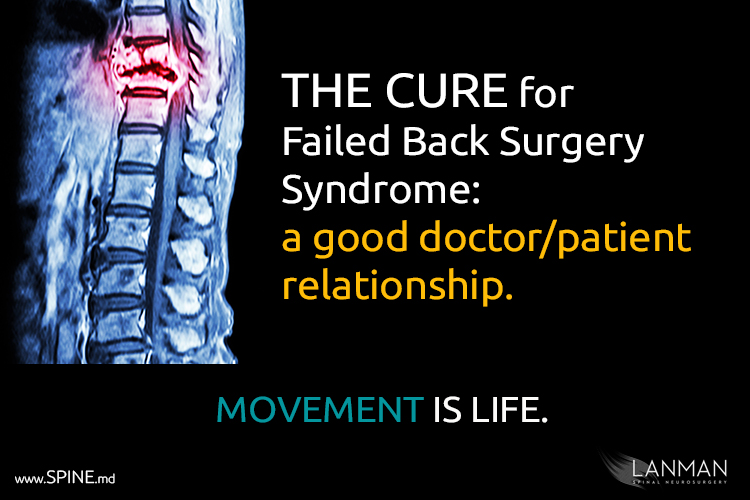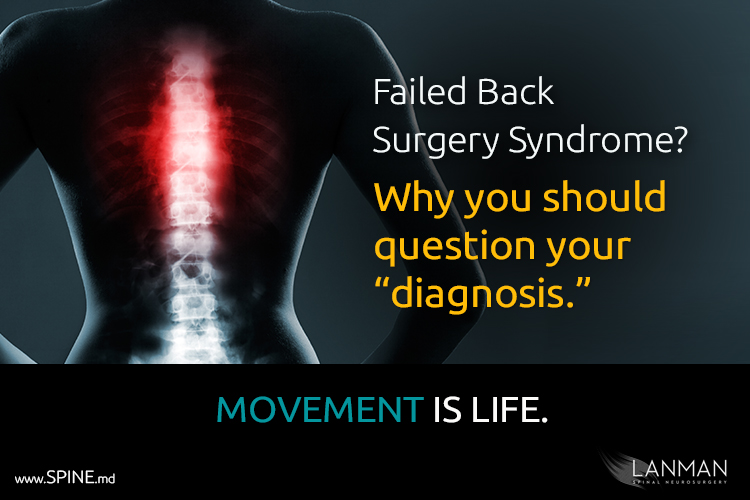Failed back surgery syndrome is a condition associated post-operatively with back surgeries. It is a diagnosis given to patients who have continued pain after back surgery. Also known as failed back syndrome on the web, it is typically associated with chronic and persistent pain at or near the surgery location.
In my opinion, the label “syndrome” is misplaced. Purely from a clinical standpoint, post-operative pain is not linked – in any way – to pathogenesis, which would be something else completely. While it may be recognized as a complication from some surgeries, no clinician can point to a specific cause and say that an actual “syndrome” exists. But that’s not my only problem with this diagnosis.
Practicing spinal neurosurgery for over 25 years. I have a practice in Beverly Hills, CA and I am affiliated with Cedar Sinai Medical Center in Los Angeles, CA. I have seen many patients with as different conditions and situations as you can imagine. Back pain and neck pain – these are universal complaints that affect people of nearly all ages, in all circumstances, with wide-ranging causes. Based on my years of study of this condition, I have not found ONE case where the leading cause of continued pain is due to the formation of post-operative scar tissue.
I’ve seen many patients who have this diagnosis. They come to see me after having surgery from other surgeons. Some come from my practice. The patients who have continued pain require careful examination. I interview them and review their studies from before their surgery. I review post-operative studies and research the type of surgery performed, with what equipment – I leave no stone unturned. And yet, I’m surprised how many patients with this diagnosis insist that their doctor told them that the cause of pain is scar tissue.
First off, there’s nothing anyone can do about scarring. Major surgery of this type WILL leave scars. Some patients who – based on their reading of sources they find on the web (which is often based on anecdotal in clinical data) – tell me that scarring can be avoided. That scarring is evidence of some error. The truth is, the “scarring” is evidence, but it’s not what people think.
For some patients with complicated conditions, one surgery may not be the final answer. There could be additional situations that are uncovered by surgery. Some problems develop over time. We are, after all, talking about the human body – not a machine. Healing a patient is part science and part art. The individual skills and habits of a surgeon often have an enormous determination on patient outcomes.
That’s why I spend so much time with my patients. My primary goal when I first meet any patient is to ensure that they are appropriately and adequately assessed preoperatively. It surprises me sometimes when I meet a patient who was not selected correctly for surgery that was prescribed. Four principal types of spinal surgeries can be performed: laminectomy, discectomy, spinal fusion, and artificial disc replacement. Sometimes, a combination of all of these procedures may be necessary.
One of the significant problems I see in my field is the pressure to spend as little time as necessary with the patient to establish the treatment plan. Some surgeons pay as little as 5 minutes with the patient. I usually spend at least an hour with a new patient on the first meeting; sometimes an hour and a half. I review the patient’s life and lifestyle. I’m not just interested in their disease state. And I’m also not a surgeon who treats only for what’s found on the MRI or the X-ray film.
I believe that surgeons who streamline the process are focusing too much on what their tools say and not enough on what the patient could tell them. They are not analyzing the symptomatology by driving to the precise source of the patient’s pain and the conditions that led up to the pain, to begin with. When you streamline too much, you end up prescribing surgery that has a high probability of failing to address the primary and secondary causes of pain adequately.
For every case, there are clues to why the patient came to me in the first place. Move too fast, and you will overlook even the most obvious ones. Even after the surgery, I have found some surgeons streamlining their evaluation. This is where critical clues may emerge!
For instance, it is not all that uncommonly that for spinal fusion surgery, many doctors simply take an x-ray postoperatively and send the patient on their way. However, the way we do fusion surgeries these days with interbody implants placed within the disc space, it is my opinion that x-rays are not enough to evaluate the proper healing of the bone in the areas of the surgery.
I prefer to perform a CAT scan at three-month postoperative intervals. This aggressive type of imaging is conducive to identifying potential non healing bones, small cracks or breakages in the hardware, bone fragments that may still be impinging on a nerve. I have also found that such details are easy to miss with MRI because the imaging does not give excellent detail of bone or bone healing, bone spurs.
The point is, I spend time with the patient: preoperatively, postoperatively, and proactively. I don’t assume that I have all the answers in the first 5 minutes of discussion. I don’t assume I have all the answers even after the first hour. If more surgeons spent more time with their patients, I believe that there would be far fewer complaints of a “syndrome” and definitely far fewer assumptions about things like scarring.
After all, it’s all about being greater than better.







